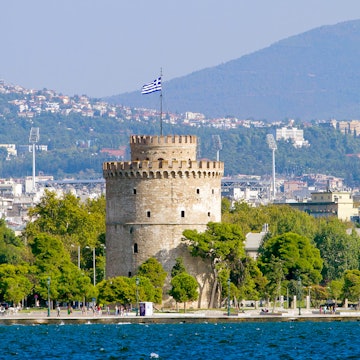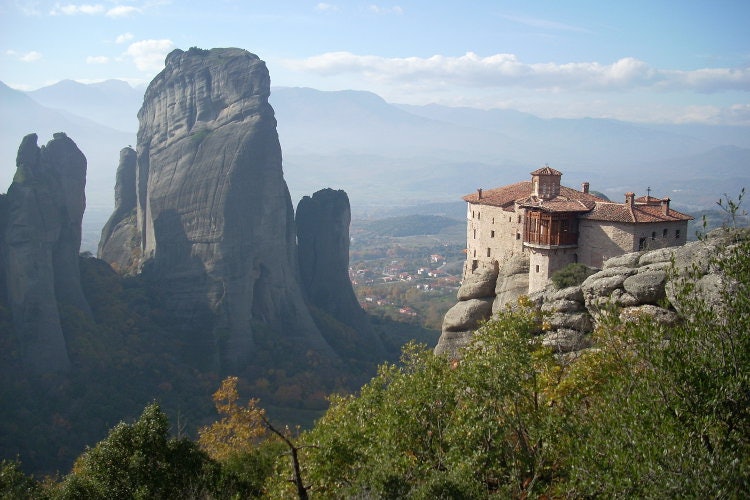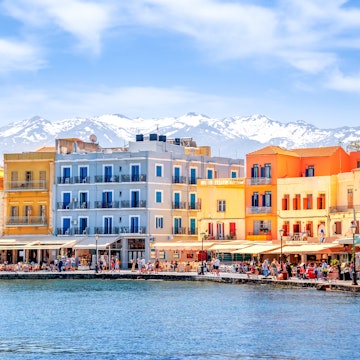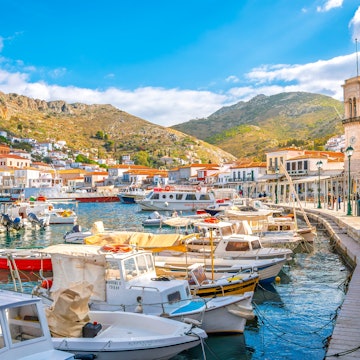

Monasteries perch on rocky pinnacles at central Greece’s Meteora © Alexis Averbuck / Lonely Planet
The mention of Greece brings up images of white arcing beaches and sparkling aqua waters under sun-drenched skies. But this nation actually offers some of its best features outside the tourist-crazed summer season. Greece in winter is a land of glorious walks with open vistas, uncluttered ancient sites and bustling city life. To help you bust those hot-weather stereotypes, here are the top things to do in Greece in winter.

Booming Athens and sleepy Peloponnese
Athens’ cafe culture and zippy late-hours, hard-partying nightlife is at its best in winter when locals are in town, not out on the islands. Athenians love a good, long, ouzo-soaked lunch or a multi-hour chat over coffee as much as they do all-night bar crawls and glittery bouzoukia nightclubs. By day, the visitor can take in a much less impeded Acropolis and other ancient sites, as well as uncrowded world-class museums, such as the Acropolis Museum, National Archaeological Museum, the Benaki Museum and the brand new Basil & Elise Goulandris Foundation.
Just a stone’s throw from Athens, the Peloponnese offers some of Greece’s most accessible, beautiful country lanes lined by stone walls and olive groves, and ancient sites spanning eons. Make a base in Nafplio, the charming seaside Venetian city topped by a fortress. Its tiny streets are packed with creative craft shops and boutique hotels, while Fougaro cultural centre hosts a winter programme of arts and musical events.

Island hopping – yes, they are open!
Let the cascade of tourists abate, and winter-time island life becomes something quite special. Convivial locals make for interesting, friendly visits. Moody skyscapes and changing light conditions make for dramatic and wonderful walks. Larger islands remain the most vibrant, with their substantial local populations.
Corfu boasts a fine old town and rich cultural life, from orchestras to art shows and its Palace of St Michael & St George. Crete sprawls from quaint, eye-dazzling harbour towns of Hania and Rethymno to its myriad mountain villages. Lesvos (Mytilini) offers ouzeries and 11 million olive trees (October and November are the olive harvest season; drop in at a local press to see it in action). Each of those large islands has some of the best regional cuisine in the country, with fresh local produce and creative recipes.

Walking trails
Larger islands such as Crete, Corfu and Lesvos are blessed with regional walking trails that connect villages to mountain churches and windswept sea coast. You can also visit smaller islands – precious Hydra has no cars at all. Stone stairways radiate out from the beautifully preserved old harbour, and earthen trails wind along the unspoilt, dramatic coast, with views across the Saronic Gulf.
Andros in the Cyclades is a walker’s haven, as is the Zagorohoria with the dramatic Vikos Gorge in the mainland’s northwest, near Ioannina. Bucolic stone hamlets are dotted around the Zagorohoria’s tree-lined valleys, all connected by footpaths, the traditional way to get around. Mt Olympus, of mythical fame, is also tops for trekkers; it’s near Litohoro in the mainland’s northwest.

Ancient sites (without the crowds)
Winter is hands-down the best time to see Greece’s ancient sites, some of the most iconic in the world and the veritable foundations of western civilisation. Practically deserted, in comparison to the teeming summer months, the mainland sites range from Athens’ Acropolis and Ancient Agora to Delphi (home of the ancient Oracle); Meteora, with its pinnacle-topped monasteries; and the awe-inspiring Macedonian tomb treasures of Vergina, outside Thessaloniki. In winter, the Temple of Poseidon on dramatic Cape Sounion actually resembles its photo on local postcards: epic, rising from its deserted seaside bluff.
The Peloponnese is also laden with impressive sites, from Olympia (home of the original Olympic Games), to Mycenae, Corinth and Epidavros with its grand ancient theatre and healing centre.
In the islands, the sacred Delos is the birthplace of twins Apollo and Artemis, with a hallowed shrine-turned-treasury and commercial centre. Naxos sports a seaside ruin of the Temple of Apollo and a fittingly pastoral Temple of Demeter. Aegina’s Temple of Aphaia stands sentinel over the Saronic Gulf, just a half-hour boat ride from Athens. Crete’s motherload of Minoan sites include heavily restored Palace of Knossos with its vibrant murals, to lesser-visited ruins at Phaestos, Agia Triada and Malia; not to mention there’s a world-class Iraklio Archaeological Museum to match. Leaving the ancient world, explore Venetian and other fortresses such as those in Corfu and Nafplio or the historic bastions and palaces of spectacular Unesco-protected Rhodes’ Old Town.
Winter festivals
Special festivities add splash to the winter in Greece. The cosmopolitan seafront city of Thessaloniki holds its renowned International Film Festival in early November, with a focus on independent cinema. Christmas in Greece means decorations on all the island harbour fronts, lights glistening in the waters of the Aegean.
New Year’s Day is also known as the day of Agios Vasilios (St Basil), and it’s marked by the cutting of the traditional vasilopita (golden glazed cake for New Year’s Eve, one slice of which will contain a good-luck coin). Next up is Epiphany (also known as Theophany), on 6 January, with the blessing of local waters in commemoration of St John’s baptism of Jesus. Across the country, Orthodox priests throw the holy cross into the waters, and local men and boys dive in to get it; the largest ceremony is held at Piraeus.
The season culminates in the grand Apokreas celebration. This Greek form of Carnival usually happens in February or March, but each year the date is different as it occurs just prior to the 40 days of Lent leading to Greek Orthodox Easter. During Apokreas, even in small villages people eat and drink, don costumes and parade in the streets. The best-known celebrations are in Patra (Patras) in the Peloponnese, Skyros in the Sporades and Xanthi in northeastern Greece, while Rethymno in Crete celebrates with a bit of Venetian flair.
Article first published in January 2015, and last updated by Vangelis Koronakis in October 2019
You might also like:
The 10 best museums in Athens
Top 10 winter destinations in Europe
Uncovering Athens' best-kept secrets
Make sure you're ready for anything with travel insurance from our trusted partners. Check out adventure tours for every traveller from our trusted partners.















